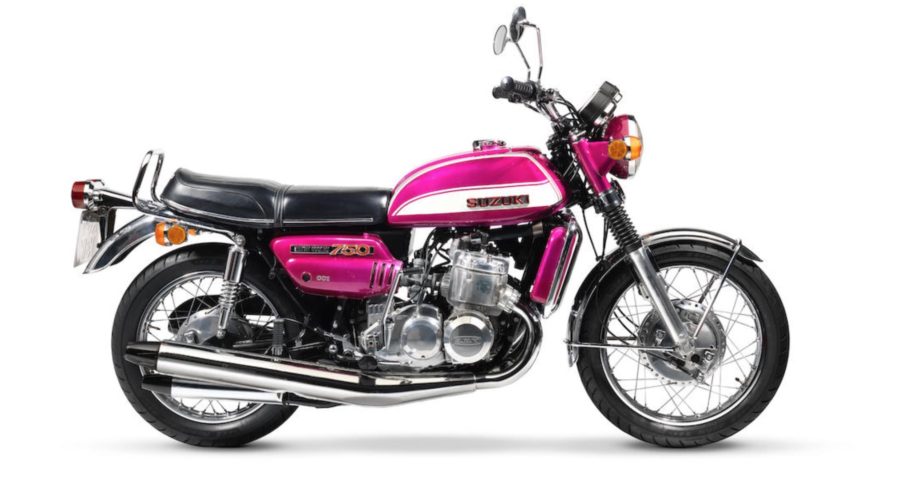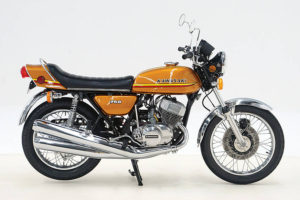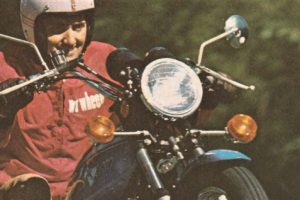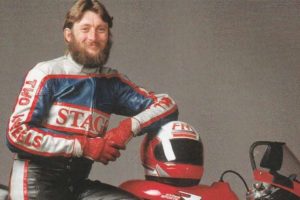1972 Suzuki GT750
Suzuki’s water-cooled triple is no boulevard brainsnapper. You lose at the lights, but win the race in open touring country – or just with suavely-styled good looks! Derek Pickard reports.
First gear goes in with a “clunk”, the revs reach 5500 and you feed in the clutch.
Blast off is child’s play, no tendency to lift, or burn expensive rubber. The revs hit the red line and the change at 7500 (40 mph) is noisy.
The 60 mark comes in five seconds, you hit third at nearly 65, change again at 80 and fourth hits the magic ton in 15 seconds.
From now on the bike is in top gear country and that is where the acceleration finishes. The bike crawls up to 105 and beyond that is a matter of waiting. It has completely run out of breath yet the revs are below the maximum power reading.
The tester drops flat on the tank behind the instruments, unable to see the track immediately behind the near-stationary instrument needles.
With luck it peaks at 110 mph as the bike tears past the amphometers at the end of the strip before the nerve-racking braking to the limit for the bottom corner.
That’s typical of our performance runs on the Suzuki’s new GT 750. Though the performance up to the ton is more-or-less on par with other 750s, the new Suzuki is disappointing in top gear when the rider is looking for speeds well into the three figures.
It’s hard to understand why. In the low gears the engine behaves as though maximum power is developed at over 7000 rpm, yet in top there seems nothing left above 105 mph, and at this speed the motor is turning over at 6400 rpm. However, as the triple pulls rapidly up to seven and a half in the first four gears, we were looking for nearly 120 mph in the test and were disappointed when the absolute maximum obtained was only 110 – and that was only 80 percent of the time.
Some people might say that it is unfair to make such a big thing of this aspect of the Suzuki’s performance when the bike is basically a tourer and tuned for good flexibility. But Suzuki have been singing this machine’s praises as being more than a match for the Honda 750/4.

It seems fair to compare their best performance as they both weigh-in within a few pounds of each other and have identical maximum power claims of 67 bhp.
We matched the two of them on a long straight to find out how they compared through the speed range under maximum acceleration.
The Honda gained nearly half a length coming off the line which it easily held right up to about 80 mph when it seemed to pull away even further and at over the ton went right away to record a top speed of 124 against 110 of the two-stroke.
Another comparison test was to let the two machines run together at 45 mph in top gear and at a signal both were to accelerate to their maximum without changing gear. The Suzy left the Honda for dead!
Due to the low centre of gravity and front end geometry the Suzuki is far easier to handle at low speeds and shunting the bike in and out of a city centre parking space makes this 750 feel a great deal lighter.
This, of course, proves the bike to be exactly what dealers are now claiming it to be: a fabulously flexible and smooth fast tourer.
Technically speaking, the engine is really different and unquestionably the most complex two-stroke yet. The makers claim some parts are interchangeable with the 250s and that the port timing was developed from Joel Robert’s world championship winning machine.
The really different part of the motor is its water cooling which is similar to that on most cars. From cold up to 82 degrees Centigrade a quick warm-up is assured by the closed thermostat causing the water merely to travel up the block (driven by a crankshaft end impeller) with a by-pass hose returning it to the bottom of the block.

Once the thermostat is opened half the coolant goes through the radiator and half around the by-pass hose; above 95 degrees Centigrade the thermostat opens fully and shuts off the by-pass completely causing the radiator to be fully used. If 105 degrees C is ever reached then the electric fan is automatically switched on.
As the cylinders are water cooled – and in our opinion that is the best way lo ensure proper cooling of the centre cylinder – the bores are closer together due to the absence of fins and the fact that the transfer ports do not lie transversely across the motor. Instead they are turned at a diagonal. This results in the block being only 16 inches wide.
Another big reason for water cooling is that on most two-stroke “multis” the latent heat qualities of petrol are used to help cool the engine – especially the centre cylinder – with the result that fuel consumption is excessive.
Oil build-up in the bottom of the crankcase is one reason why many two strokes emit a “blue haze” out of the rear. Suzuki overcome this problem by fitting check valves between these chambers. These one-way valves allow excessive oil from one case to pass to the next without any drop in primary compression.
Suzuki’s CCI lubrication has proved successful in the past and there is no reason to expect anything else on their latest engine. The oil pump (as always) is driven off the gearbox which means that owners should make a point of not holding the clutch in for long periods.
The main bearing next to the gear drive to the clutch (between the centre and right hand cylinders) is lubricated by the transmission oil. The clutch turns faster than most other machines which means a limitation on quick changing in the low gears.
Electrics consist of the generator on the right hand side, the contact points on the other end of the crankshaft and the starter motor connecting to the left hand end via gears and an over-run clutch.
The entire engine assembly is fixed to the frame by eight rubber mountings which allow slight movement – visible when blipping the throttle at tickover – but no doubt contribute to the superb smoothness of the machine at speed.

Though the motor is extremely intricate for a stroker, tuning is made easy. All three carb slides can be synchronised in a couple of minutes by removing a screw plug from the carb body which allows a mark on the slide to be sighted and the control cable slack adjusted till this mark is set in the screw hole. After the three slides have been set, the oil pump control is adjusted by unscrewing a small cover and turning the cable adjuster till two marks are lined up. This way a home mechanic can be sure of balancing the mixture very simply .
Other features worth mentioning are the thin plastic components – side panels and chainguard, the wide centre stand, the close proximity of all the switches on the left hand switch cluster … and the front brake.
The front stopper is a double sided “500” unit. While the brake is sufficient for normal work and the occasional panic halt (23 ft from 30 mph is excellent) the 500 lb weight makes its presence felt when a couple or quick stops are required on a fast downhill stretch. Fade is not too bad but it occurs nevertheless. Without doubt a disc is required.
An interesting point is that the bottom fork legs have huge brackets cast on their sides and only the two lower threaded holes are used – for brake anchor arms. Unused are two huge robust threaded holes which must be there for future use.
We would guess that next year twin discs will appear on the front of the GT 750 with the hydraulic calipers mounted on the present lugs.

Most superbikes come equipped with a toolkit to match the rest of the bike’s dynamic specifications. Not so with the GT 750. A dozen or so five-inch weak tools in a thin plastic bag are the lot. The result is near inefficiency when adjusting the rear wheel and difficulty when attempting to remove the centre spark plug on a hot motor.
The wide seat is very comfortable but is a little high for anyone under 5 ft 9 in. The riding position is excellent for touring with its medium rise bars and slightly backward footrests.
These pegs are wide and do obstruct the rider’s legs when on the ground while the bike is stationary. The right-hand peg catches the toe of the foot if the kickstarter is used. As the kickstart lever has to be cranked out to clear the large exhaust system it does not completely fold away and rubs against the inside of the calf. A little more work by the engineers might have overcome these small points.
Due to differing safety regulations for motorcycles around the world two different types of left hand switch clusters are made Both are coming to Australia. The American and Canadian models have the light on/off switch on top of the cluster followed by the high/low selector on the back. Below that is the flasher switch and at the bottom the horn button. European regulations demand the inclusion of a headlamp flasher which connects to the main beam during daylight, low beam when riding at night on main beam and vice versa.
The switches are (working from the top): headlight high/low/off switch, flasher selector, horn button and at the bottom the headlight flasher button which is marked with a “P” as this facility is used to indicate intention to pass on fast European motorways.
The entire electrical system is above criticism from the the excellent front beam to the huge bright rear light.

Starting is a matter of turning the ignition key, which operates the neutral light, and the turning of the right hand ignition on/off switch permits the starter button to bring instant life. The diaphragm-type petrol tap is always on and the choke need only be used in the winter.
Tickover is an even 1300 rpm which emits a barely audible burble from the four silencers. For a supersports multi the engine is the quietest ever due to the mechanical noises being quietened by the effects of the water jacket and the extreme efficiency of the silencers. Slight vibration is felt from tickover to 2500 rpm when stationary but this completely disappears when moving.
The gearbox operation is not up to expectations and first gear needs a lot of pedal pressure to engage it. When it does go in, the extinguishing of the neutral light is not the only way the rider knows the bike is ready for the off. The audible “clunk” is more than sufficient warning. The shift to second is just as bad but the notchiness and noisiness disappear for the top three gears. However often we tried the changes, into first, from first to second and from second to first, the shift never improved.
Blipping the throttle to around 2000 rpm ensures a smooth pull away with real power surging in at 3000 rpm. The flexibility of the motor is a delight as the power curve is absolutely flat from three to six thousand. The bike feels at its best from 35 to 100 mph when the top four gears are being used – so avoiding the “clunk” of going through neutral, and using top only as a tractable overdrive.
The engine is as smooth and quiet as a well-balanced turbine with good acceleration coming in at any gear without the need for going down a few cogs. We took delight in riding side by side with the Honda through country towns and when the “end 45” mph signs were passed with both bikes in top gear, the Suzy had only to be opened up to let the velvet-smooth power come surging in and leaving the Four to either fall behind or have to change down twice to match the stroker’s power.
It is at this midrange, top gear acceleration that the GT 750 can claim to have the edge.
For hard work around the ton the front drum has its shortcomings and acceleration in the three figures is practically non-existent. Whether we had a slow bike or not we cannot be sure, but the running adjustments were spot-on and over 1700 miles had been knocked up by its owner, Graham Lang of Melbourne Motorcycle Company.
The worst point about fast work is the road-holding. Out of 20 high speed runs the bike developed a snaking action six times at around the ton. Altering tyre pressures and suspension settings did little to cure this. The handling is fine at slow speeds and very competitive up to about 90 but then the steering geometry seems to lack any positive castor effect and tearing around bumpy corners at nearing the hundred mark can cause the bike to start snaking all over the road – a precarious situation that brought premature nervous breakdowns to our test staff!

No steering damper is fitted and we feel future owners should consider bolting on a telescopic fluid unit. A radiator core guard cut from wire mesh would also be a wise fitting to protect against the odd stone.
We were fortunate in having two bikes at our disposal for testing purposes. Graham Lang’s which was the one we used for blasting as it was fully run in, and a later model belonging to Hans Hari of Malvern Motorcycles who managed to obtain the best conceivable registration number – GT 750 – but with only 400 miles on the speedo it could not be used to confirm the readings of the other.
Suzuki claim present production models do have a better front end set up for high speed directional stability. This we can neither confirm nor deny as our test models were about the first in the country before the regular models arrived, although it is hard to believe that a huge maker such as Suzuki would let a fault as basic as steering geometry go unaltered.
At anything less than ultra-high speed work the triple averages nearly 50 mpg and around 170 miles per pint of oil. An unusual point is that most of the small amount of oil haze that does come out of the rear end seems to come from the two bottom pipes. We very much doubt that the centre cylinder is burning more oil, more than likely the primary pipe junctions which connect to the split centre pipe probably act with a mild extractor effect.
We were amazed by the perfect temperature control the cooling system has on the engine. The needle comes up to the half-way mark in only a couple of miles and there it stays. Our tests were made in sunny conditions up to 90 degrees F and still the temperature gauge needle would not go over the half-way (normal) mark. The only way we got the fan to cut in was to park the bike in the sun and keep it revving. Maybe a slow traffic crawl with the air temperature over the hundred would have the same effect but we did not get the opportunity to prove it.
The temperature gauge sits above the two main instruments and is rubber-insulated against vibration. The only possible fault with an otherwise perfect instrumentation setup is the lack of a generator warning light. All the dials sit up at 45 degrees making their ease of reading amongst the best.
Though the long-awaited big Suzuki is not an outperformer compared with other superbikes, it has a degree of mid-range smooth power that is absolutely unmatched and makes it one or the finest two-strokes and certainly the smoothest and most enjoyable tourer we’ve had the pleasure of riding.
Cleaning up the bike at the end of a very pleasurable eight days was one of the hardest polishing jobs we have ever undertaken. If sophistication means complication which combines with fluted panels to result in a near day-long cleaning task a great many fast tourers of the future will tour dirty.
The GT 750 has too many little places that collect dirt and most of the normally flat surfaces have scallops or flutes which although looking attractive demand a lot of maintenance to keep that way.
But after using up a couple of buckets of degreasing hot soapy water, nearly a bale of rag and a tin of polish, the end product was certainly well worth working for. When the Suzuki GT 750 shines it does so like no other and it ranks as the most attractive sports tourer we’ve ridden.
By Derek Pickard. Two Wheels, June 1972.





